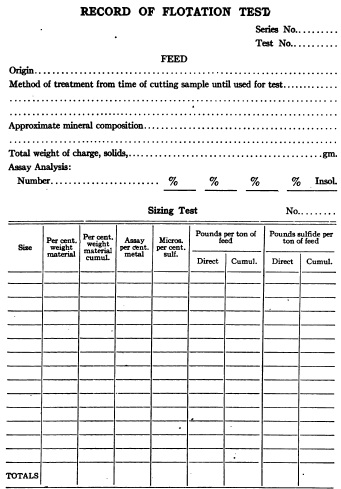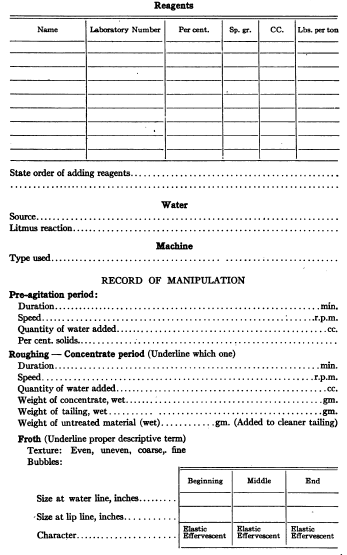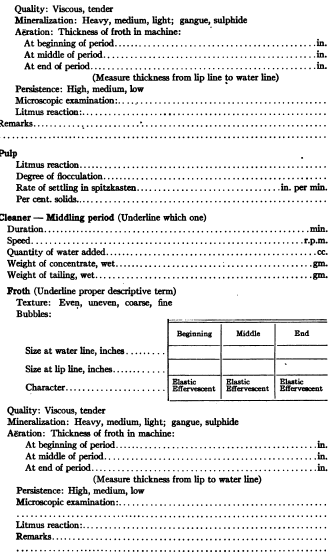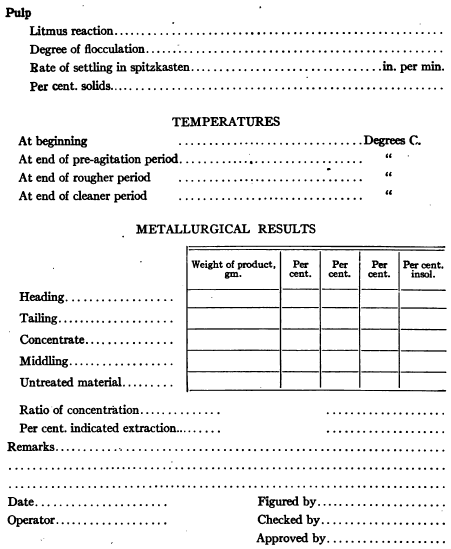Table of Contents
Practice in testing ores for flotation varies, of course, in its detail, from practice in testing work for other purposes, but in this as in other such work certain general principles apply. These principles would seem to be so obvious that they should not need to be enunciated, but the writer has found in going over the results of extensive series of tests done by others, and even in directing work in his own laboratory, that the rules, simple as they are, are likely to be more honored in the breach than in the observance.
The general rules follow:
- Keep a careful, detailed record, during the course of every test, of every feature connected with the test, making special note of all conditions surrounding any unusual performance.
- In keeping the records, express weights, volumes, distances and time in the accepted units, and in describing appearances and performances use a terminology that will convey a picture to a person who has not seen the work, is not familiar with the operator, and who may not be familiar, even, with the subject under investigation.
- Keep the original record of the test neatly, in ink, or better with a medium hard pencil. Take all notes other than those recording routine tests, in a stiff-backed, tight-leaf book, of convenient size for the pocket of the operator. Date every page. When a report is made up from the original notes indicate the fact on each page so written up by an appropriate inconspicuous symbol. Differentiate in the book of original record between data entered at the time of the test and data computed or subsequently entered (such, for instance, as assays and recoveries) by making the later entries in a different colored ink or by some similar device. Have the record of each day’s work or each separate test signed by the person in charge of the test with a note as to the personnel of the testing crew and the duties of each member. Keep the original records of routine tests on printed or mimeographed forms. These forms should be the product of the best thought of the man directing the work and should be frequently changed at first until it becomes apparent that they are the best possible for the purpose of conveying to others than the operator the observed facts.
- When more than one condition in a series of tests is capable of variation in such a way as to affect the result or affect the effect of another variable on the result, never change more than one such condition at a time in successive tests. It cannot be too strongly urged upon the laboratory experimenter that a given flotation test be carried through under the conditions prevailing at the beginning and that changes in condition during the course of the test, such as variation in temperature or speed of agitation or new additions of flotation agents, should be avoided. A test which starts in the cold with agitation of a given degree and with a certain amount of flotation agents present, and which, in the course of the test is subjected to the addition of heat and an increase in the degree of agitation and the addition of more flotation agents of the same or different variety, will, even though it may give a good recovery, give no information that is of use in the subsequent investigation. On the other hand, if the first test is carried through to a conclusion and marked as a failure, and a subsequent test is carried out under the conditions finally attained in the first test, such conditions, however, prevailing from the start of the test, then the results can be translated, without error, into mill practice. The question is the old one of making haste slowly, and the procedure advocated is by far the swiftest, as the writer can vouch after an experience with several thousand laboratory tests.
- Never be satisfied with a doubtful result or a questionable record. If possible repeat the work, otherwise give due weight to the doubtful character of the result or record in drawing conclusions.
- Insist upon a report by the operator immediately following the completion of each series of tests, or, in an extended series, at not longer than weekly intervals. Work up the full results of a series as soon as it is completed while the matter is fresh in mind.

The variables affecting froth flotation
All were discussed earlier. They are enumerated in condensed form below:
1. Ore.
(a) Mineralogical character.
(b) Fineness of grinding.
(c) Method of grinding.
2. Agents.
(a) Principal flotation agent. (“Oil”)
α Character.
β Quantity.
(b) Minor agent.
α Character.
β Quantity.
3. Water.
(a) Quantity with respect to solids, i.e. pulp thickness.
(b) Character.
α Acidity or Alkalinity.
β Flotation agents.
γ Dissolved salts.
4. Apparatus
(a) Method of aeration.
(b) Method of froth removal.
5. Agitation.
6. Duration of treatment.
7. Temperature.
The variable results to be watched for and recorded
1. Recovery.
2. Grade of concentrate.
3. Rate of flotation.
4. Froth.
(a) Copiousness.
(b) Consistency.
(c) Size of bubbles.
α At pulp surface.
β At froth surface.
(d) Solid load.
5. Appearance of tailing.
(a) Flocculation.
(b) Settling rate.
A useful form for recording tests follows




Notes on Descriptive Terms
Texture:
Under this head the grain of the froth should be examined. Mental reference to the grain of a rock or other non-homogeneous mixture will help in choosing the proper descriptive term.
The texture will be described as “even” when all or a great majority of the bubbles on a given horizontal plane are of the same size. “Uneven” describes the reverse of this condition.
The texture will be described as “fine” when all or a great majority of the bubbles at 1/2″ above the water line are 1/8 or less in diameter. “Coarse” will be used to describe textures coarser than the above.
Character of Bubbles:
Under this head the behavior of the bubble films themselves should be noted.
The character is “effervescent” when the bubbles burst with considerable violence soon after reaching the surface.
The character is “elastic” when the bubble films are rather persistent on the spitz-kasten, when they may be deformed considerably without causing them to burst and when they tend to elongate markedly in overflowing the lip of the spitzkasten.
Quality:
Under this heading the nature or character of the froth as regards its behavior as a mass should be described.
The quality will be “viscous” when patches of the froth act almost as solids and the whole froth is sluggish on the cell.
The quality will be “tender” when the reverse of this condition holds, i.e.: the froth is homogeneous, fluffy, motion in one part is not transmitted to any distance and the froth as a mass is active on the surface of the cell.
Mineralization:
Under this head should be described the solid load in the bubble film. The mineralization is “heavy” when this solid load is great. It is light when the reverse is true. In general a heavily mineralized bubble will be practically opaque; a lightly mineralized bubble will be transparent to slightly translucent. “Medium” mineralization will describe the intermediate condition.
The word “gangue” or “sulphide” should be underlined in this connection when either predominates in the solid load in the bubble film.
Persistence:
“High” persistence is indicated when the froth in the collection pan shows slight or no tendency to break down after ten minutes standing. “Medium” persistence is indicated when the volume of froth spontaneously breaks down to somewhere in the neighborhood of half its volume within ten minutes. “Low” persistence is indicated by practically complete breaking down on ten minutes standing.
This form is conveniently made up in the form of a sheet 17 ins. by 11 ins. folded to 8 1/2 by 11 and punched for a loose-leaf holder on the folded margin. With such an arrangement page one runs to the heading “water,” page two to the heading “Cleaner-middling Period,” page three completes the record form, and the “Notes on Descriptive Terms” are printed on the back or fourth page.
Testing axioms
- Any ore amenable to froth flotation can be treated with equally good metallurgical results by the agitation-froth or the bubble-column process. Change in process will, however, usually require a corresponding change in some other essential condition of the flotation treatment.
- Any result that can be obtained in a laboratory machine can be duplicated on a mill scale. Whether or not the duplication of the controlling laboratory conditions in the mill can be profitably made is another matter. In general, however, such duplication is economically possible; indeed mill conditions of treatment are generally more favorable to good flotation results than laboratory conditions.
Procedure in Flotation Tests
General
Always thoroughly clean the flotation machine and the apparatus used for measuring reagents before starting any test which is intended to give information concerning the behavior of a certain flotation agent or mixture of agents. The machine is best cleaned as follows: Scrub with a strong solution of sodium carbonate, fill the machine with water and run for a short interval, draw off the water, refill the machine with clean water, add about 5 cc. of concentrated sulphuric acid, again run for a short time, draw off the water, add fresh water and a charge of waste rock ground to flotation size and again run. If no frothing occurs the machine is sufficiently clean. For routine tests where the same flotation agent is being used in successive tests it is only necessary to run the machine with a charge of the cleaning solid and water and observe lack of frothing on agitation. Of course, if any considerable amount of frothing occurs on such agitation, the apparatus should be cleaned as above before proceeding. Pipettes, burettes, etc., should always be thoroughly cleaned with oil solvents and chromic acid solution before being used.
Measurement of quantities for tests
Quantities of reagents in flotation practice are stated in this country in pounds avoirdupois per short ton of ore. It will be found simplest in test work to use metric units for measuring solids, water and reagents. The charge of solids for a test will then be weighed in grams and the water and reagents will, in general, be measured in cubic centimeters. Mobile oils and acid are best measured with a Mohr pipette (see Fig. 14). Viscous oils are measured by counting the number of drops added to the machine, a determination having been made of the number of drops per cc. and the specific gravity, or directly of the number of drops per gram. Solid reagents are, of course, weighed in, if added as solids, or the number of grams per cc. determined and the number of cc. measured if the reagent is added as a solution. Considerable time and calculation can be saved by making up a solution of sulphuric acid which shall contain 1 gm. of sulphuric acid per cc. The specific gravity of oils ranges, in general, between 0.9 and 1.1. For determining the number of cc. to be added, the calculation involving the specific gravity must, of course, be made if it is desired to add an accurate quantity. For ordinary testing work, however, it is sufficient, in calculating in the laboratory the amount of oil to be added, to take the specific gravity as one, and later make the accurate calculation of the actual amount used in pounds per ton.

The chart, Fig. 15, will save much time in calculation of reagent quantities. The method of use is as follows: Example (1): Knowing the weight of ore charge, say 500 gms., and the density of the oil or other agent, say 1.0, to find the number of cc. of oil or agent necessary to add in order to have present some given number of pounds per ton of ore, say 20; join, with a straightedge, the points 500 on the scale reading “Weight of Ore Charge in Grams” and 20 on the scale reading “Pounds of Oil per Ton of Ore” and mark the intersection with the line “X–X”; now join this point of intersection with the point 1.0 on the scale “Density of Oil” and at the intersection of the prolongation of this line with the scale reading “Cubic Centimeters of Oil” read 5.0, which is the volume of reagent that must be added to fulfill the required condition. Example (2): Given weight of charge as 500 gms., density of agent as 1.0, and, having added 5.0 cc., to find the number of pounds of agent per ton of solids that this represents; join the point 1.0 on the density scale with the point 5.0 on the volume scale and mark the intersection on “X–X”; then join this point of intersection with the point 500 on the weight-of-charge scale and at the intersection of the prolongation of this line with the pounds-of-oil scale read 20, which is the result desired.
Agitation froth machines without froth overflow
Machines of this type are the square-glass-jar, the Gabbett mixer and similar apparatus. In these machines the purpose in a test is to agitate the pulp with the flotation agent in such a way as to cause precipitation of air bubbles on all of the sulphide mineral particles and subsequent coalescence of the bubbles with their attached loads to form the heavily coated bubbles and bubble agglomerates characteristic of the agitation-froth process. The procedure is as follows: Place in the machine an amount of water sufficient, with the solid charge, to make a pulp containing 20 to 25 per cent, solids. Start the impeller slowly and add the solid charge. Add flotation agents in proper amounts, taking care that the agents get into the pulp and do not stick on the sides of the containing vessel or on the agitator shaft. Raise the speed of the impeller to that desired (1000 to 2500 r.p.m. is the usual range) and continue agitation for a period of, in general, from 6 to 10 minutes. The determination of the proper end point is in some cases extremely important, as, if the agitation is stopped too soon or carried forward too long, mediocre results only will be obtained. The proper end point can be determined by taking small samples of pulp from the machine by means of a pipette and examining them on a watch glass under a hand glass or microscope. It will be noticed in such examination that at first little or no change in the appearance of the pulp is observable. Shortly, however, small bubbles, each carrying but one or two easily visible pieces of sulphide mineral, are to be seen. Subsequent samples show an increase in the number of solid- loaded bubbles and an increase in the load on the bubbles. Finally agglomerates of solid-coated bubbles appear. At this point agitation should be stopped in order to get the maximum amount of froth. In the case of some flotation agents, such as oleic acid in a pulp containing sulphuric acid, the progress of the experiment may be watched by the color of the pulp, which changes, as the sulphide particles become agglomerated with air bubbles, to that of the gangue minerals with specks the color of the sulphide mineral, indicating the coated air bubbles. The froth which rises on cessation of agitation may be removed by introducing water into the bottom of the machine in order to raise the pulp level until the froth overflows, or by skimming with a spoon. The former method is the better. In case no provision is made in the machine for introduction of water at the bottom, this may be accomplished by means of a long-spouted funnel introduced from the pulp surface. A full record should be kept of all phenomena observed, using the form on page 53 or a similar outline as a guide.
Slide machine
This machine was devised to allow of intermittent agitation and successive removals of froth. The procedure in a test is as follows:
Introduce into the machine an amount of water equal in weight to that of the solid charge. Start the impeller slowly and introduce the solid charge. Add flotation agents in proper amounts. Raise the speed of the impeller to that to be employed in the subsequent flotation operation (1200 to 1800 r.p.m.) and agitate for about one minute to obtain thorough mixing of the flotation agents with the pulp. Add water to bring the pulp level up to the top of the lower compartment. Start the impeller and continue agitation for about two minutes. Stop the impeller and allow froth to rise. Remove the clamps and slide the froth obtained into a pan. Replace the top, again add water to raise the pulp level to the top of the lower compartment, agitate for another period of two minutes and again remove froth. Repeat this operation as often as is necessary to obtain a clean tailing or until further repetitions produce no apparent improvement in the final result. The various froths removed will correspond very roughly to those to be expected from successive cells of a mill-sized Minerals Separation machine working on the same ore and under the same conditions, the two- minute intervals allowed corresponding to the average time of passage of pulp through a mill-sized flotation cell. Note, however, that a mill operation will not be subject to the same variations in percentage of solids in successive cells that are present in this test. Use form on page 53 to record observations.
Janney laboratory machine
Place in the machine an amount of water equal in weight to that of the solid charge to be used. Start the impeller slowly. Add the solid charge. Add the flotation agents. Place the cover on the machine in an inverted position, bring the impeller up to speed (1800 to 2500 r.p.m.) and agitate for one minute. Remove the cover and wash the adhering pulp down into the machine. Place cover on machine in an erect position and add water until the pulp level in the froth-separating compartment is within one inch of the level of the overflow lip or, in the case of a test in which there is considerable frothing, until the froth begins to overflow without help. Carry forward froth formation and removal for a length of time to be determined by the appearance of the froth removed and the residual pulp, bearing in mind that each two-minute interval corresponds roughly to the passage of the pulp through one cell of a mill-sized Janney mechanical machine. During the test keep pulp level up to necessary height by addition of water. In case it is desired to test for a mill installation which is to make finished concentrate on the early cells and middling on the later cells, the froth removed at successive two-minute intervals should be caught separately and later combined according to the judgment of the operator, or assayed separately. In case the test is to give information concerning the performance of a pulp in a flow sheet of the rougher-cleaner variety (see page 139) in which a rough concentrate is to be taken from an early machine and cleaned in a later machine, all of the froth collected in the first frothing operation is re-treated in the machine after the residual pulp from the first operation has been removed. In such a case the residual pulp from the first frothing operation represents the rougher tailing to be expected, the finished froth of the second operation represents the cleaner concentrate, and the tailing from the second operation represents the cleaner tailing or middling of the process which would be returned to the circuit. The record form on page 53 is designed particularly for tests in this type of machine.
Minerals Separation machine
Procedure in this machine is similar to that described above for the Janney machine except insofar as concerns the manipulation of the cover, which latter is lacking in the case of the Minerals Separation machine.
Pneumatic machine
In ordinary mill operation of pneumatic machines the flotation agent has usually been pre-mixed with the feed to the machine. One method of pre-mixing is to add the flotation agent to the grinding mills. If such procedure is employed or contemplated in the mill, then for laboratory tests, a charge of ore, dry-ground somewhat coarser than is desired for the flotation operation, should be mixed with the proper amount of flotation agents and enough water to make the consistency 1:1, and ground in a ball or pebble mill. If sulphuric acid is to be used, a silex-lined pebble mill should be employed. The duration of the grinding should be sufficient to bring the pulp to a size suitable for the flotation operation. The charge of thick pulp should next be thinned by the addition of water and then be introduced into the flotation machine with the air turned on and the tailing exit closed. From this point the procedure varies according to the character of the test installation. If a non-circulating test is to be run, the tailing exit is kept closed for the duration of the test and sufficient air is turned on to cause overflow of froth without any considerable disturbance of the pulp. The air should also be regulated in the different compartments so that there is no marked eddying from a center over any given compartment. The frothing period should be continued until the tailing shows a marked impoverishment or until 8 to 10 minutes have elapsed. This time corresponds to that required for the passage of pulp through an ordinary Callow machine under normal operating conditions. If, at the end of this time, no marked impoverishment in the tailing is noticeable, it may be concluded that the particular combination of ore and flotation agent is unsatisfactory. In case the apparatus shown in Fig. 9, with pulp circulation, is to be employed, the procedure recommended by the General Engineering Co. is as follows: Open valves (A), (B), (B′) and (D) and crack valves (C) and (C′). Put about two inches of clear water in the cleaner cell and wet down the-sides and blanket of the rougher cell. Pour the prepared sample into the rougher cell and open valve (C) until froth starts to overflow. If the froth overflow is uneven, adjust the valves (B) until a satisfactory overflow is obtained. Thereafter regulate the air supply entirely by valve (C). Adjust the air supply in the cleaner cell in like manner. Turn cock (F) to allow pulp to discharge into the air lift. Carry the water level in the rougher cell at from three to five inches below the overflow lip, and in the cleaner cell at from two to four inches below, adjusting the level in the rougher cell by the addition of water and in the cleaner cell by regulation of the siphon (E). Continue circulation of the pulp as long as mineral-bearing froth is discharged from the rougher cell. This should not be more than 10 to 20 minutes in case of a proper combination of flotation agents. A few minutes before the end of the test the material in the air lift should be collected by pulling the cork (I) and draining into a bucket. This material should be poured directly into the rougher cell. At the end of the test remove the tailing from the rougher cell by turning the cock (F) so that it discharges through the pipe (H) into a bucket. Wash the blanket thoroughly. Collect pulp from air lift. Collect cleaner tailing by manipulating the siphon (E). The blanket in the cleaner cell should be cleaned by washing with water. The tailing from the rougher cell will represent the rougher tailing from a mill plant run under the conditions of the test, the cleaner concentrate the corresponding product from the mill, and the cleaner tailing the circulating middling. The General Engineering Company presents the following method of physically disposing of the cleaner tailing: “Plaque out the mineral and add it to the original concentrates already obtained, the remainder being added to the rougher tails;”
Procedure in other laboratory pneumatic machines may easily be inferred from the detailed instructions just given.
Vacuum machine
For a test in this machine a charge of 300 to 500 gms. of ore is added to an equal weight or less of water, the quantity of water being about sufficient to make a pulp of the consistency of fairly thick cream, and to this is added oil in an amount equal to from 1 to 5 lbs. per ton. The oil used may be any of the oils common to present day flotation practice or a fatty or mineral oil. The choice of oil will depend to some extent on the kind of ore to be treated. The mixture of pulp and oil is thoroughly stirred to insure dispersion of the oil throughout the pulp. Stirring for several minutes with a rod or spatula, or for a shorter length of time in an apparatus such as the square-glass-jar machine, is sufficient to accomplish the required dispersion. In some cases it may be advisable to add sulphuric acid, and in some cases to heat the pulp to between 30° and 40° C. The apparatus is now filled with water to a depth of about 2 inches, the valve (A) is closed, and a suction of about 5 inches of mercury is applied. The pulp is next poured into the funnel (B) and the delivery into the separating chamber is regulated, by means of the valve (A), in such a way as to prevent inrush of air. After all the pulp is in the separating chamber, water is added until the level of liquid in the inverted funnel stands at 1 to 2 inches below the neck. The vacuum is now increased gradually and the rake started revolving at from 10 to 12 r.p.m. Agglomerates will be seen to form, most easily in the sand at the bottom of the apparatus, and to rise to the surface of the liquid, forming there a heavily mineralized, stiff froth. This will gradually build up until it overflows into the dome (J) and through the pipe (E) into the concentrate collecting vessel (F). In the course of 20 to 30 minutes the vacuum is increased to 22 to 26 inches of mercury. Water is added at intervals to replace the water overflowed in the form of froth. At the expiration of the flotation period the vacuum is released, the valve on the tailing discharge pipe is opened, the tailing is drawn off and the dome (J) is removed and washed free from settled concentrate.
Potter-Delprat process
No special apparatus is needed for a test of this process. A funnel with preferably about 30 degrees apex angle and 300 or 400 cc. capacity is sufficient. This is connected by means of rubber tubing with an acidproof reservoir set so as to have a head of 4 or 5 ft. on the point of discharge into the funnel. The charge of moist ore is placed in the funnel and hot acid or acid salt cake solution (in the case of sulphuric acid, with a strength of from 1 to 10 per cent.; in the case of acid salt cake solution, having a density of 1.3 to 1.4) is slowly added. Almost immediately upon the addition of acid, agglomerates of air bubbles and sulphide mineral particles will be seen to form in the body of the pulp and gradually these will rise to the surface to form a thick, coherent, heavily mineralized froth. If the capacity of the funnel is sufficient to allow for several minutes collection of froth before overflow takes place, a froth from 1/2 inch to 1 inch thick will easily build up. After the liquid level has reached the overflow rim of the funnel and liquid begins to overflow, there is, of course, no opportunity for froth to build up, and consequently the mineral will come over as agglomerates not collected together in the usual froth form. A somewhat more elaborate apparatus may be made by reproducing on a small scale the pointed box shown in Fig. 27. Such a box, about 10 or 12 inches deep with one or two sides made of glass, with a top-regulated ball valve for tailing discharge, can, with care, be operated to give a good idea of mill practice with this process.
Continuous tests with machines of the size described in this chapter will not give satisfactory indications of what can be expected from mill operations.
The subject matter of most flotation tests will fall under one of the following heads:
1. Amenability of an ore to flotation.
2. Process of treatment for an ore.
3. Flotation agents.
P. 75-94
